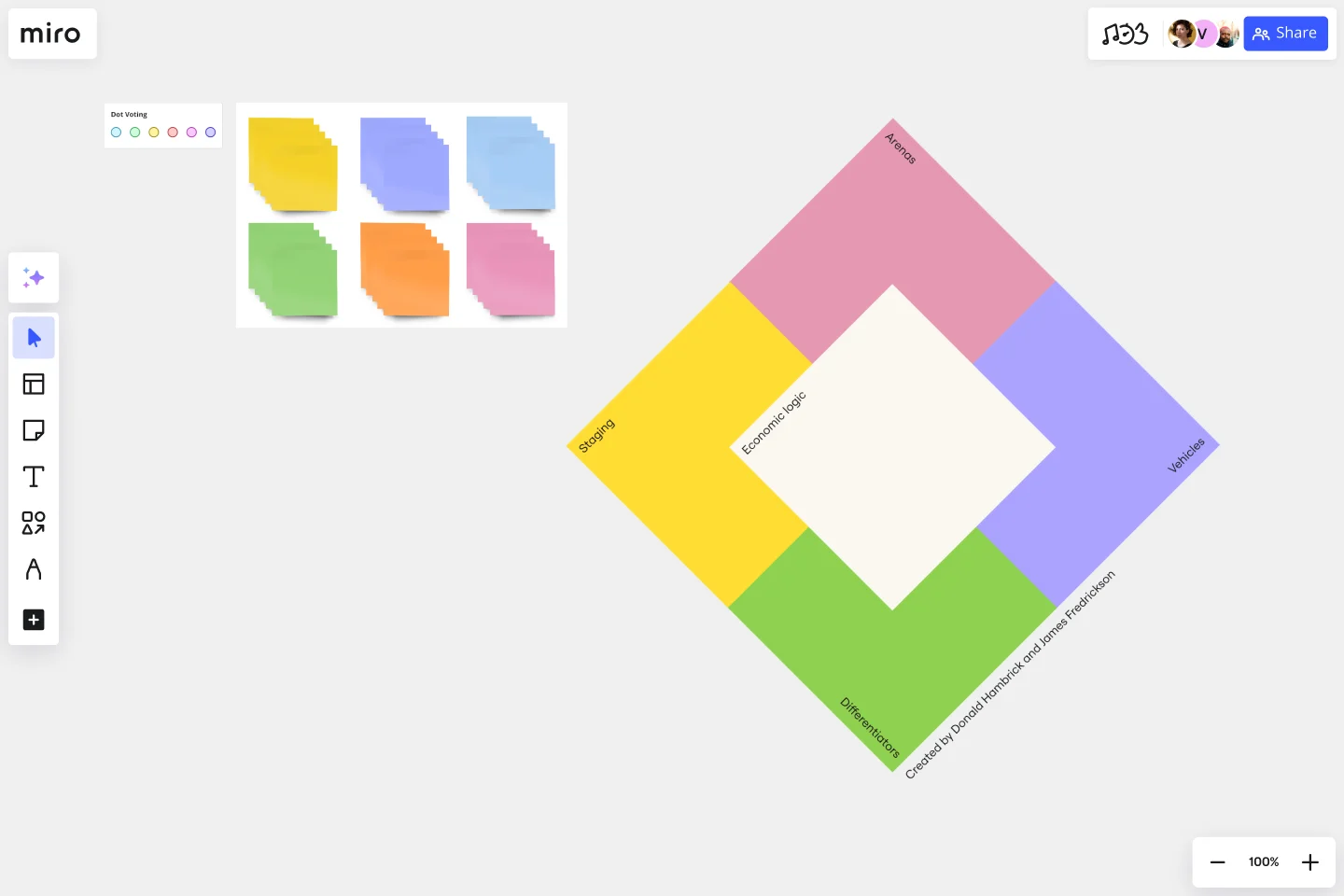Strategy Diamond Template
Consider all the elements you need to create an integrated and powerful business strategy using our template for the Strategy Diamond Model.
About the Strategy Diamond Template
What is a strategy diamond?
A strategy diamond is a collection of the five elements forming a coherent business strategy. These five elements of strategy include Arenas, Differentiators, Vehicles, Staging, and Economic Logic. This model was developed by strategy researchers Donald Hambrick and James Fredrickson.
To achieve key objectives, every business must assemble a series of strategies. But what elements should you consider when building a strategy? How can you stay ahead of your competitors while also building your brand and bottom line? Using a strategy diamond provides a framework for covering all of these important elements of a strategic plan.
How do you use a strategy diamond?
Completing your own strategy diamond is easy. Miro’s visual collaboration platform is the perfect canvas to create and share this integrated strategy model. Get started by selecting this strategy diamond template.
An effective strategy contains these key elements: Arenas, Differentiators, Vehicles, Staging, and Economic Logic. It’s important to consider each of the five elements in the strategy diamond model below because they are all interrelated and mutually reinforcing.
Arenas: What do we plan to achieve? What is the nature of our products, services, distribution channels, and market segments? What geographic areas do we plan to expand into? What technologies will we use?
Differentiators: What sets us apart from our competition? Is it an image, price, product dependability, and how quickly we get our product to the marketplace? How will we win the marketplace?
Vehicles: How will we get there? Will we get there through strategic alliances? Development? Licensing?
Staging: How will we advance our product or positioning? How quickly will we move? In what order we will move forward?
Economic logic: How will we obtain our returns? Will this be achieved by lowering costs to give value for the price? Providing premium services for premium pricing?
What are the advantages of using a strategy diamond?
Most strategic plans focus on just one or two of these elements, creating gaps that might cause problems for your business later on. A strategy diamond can help you stay focused and ensure you’re fulfilling all of your business’s needs rather than one or two.
When to use the strategy diamond model
A strategy diamond is designed to help you consider the most important questions you’ll need to answer when your team defines your business strategy. Organizing the strategy as a whole – so that each part integrates with the others – helps you figure out your business’s goals and the best way to achieve them.
Discover more product strategy template examples to help you build your next big thing.
What is the purpose of the strategy diamond?
The Strategy Diamond Model was developed by strategy researchers, Donald Hambrick and James Fredrickson. This framework helps companies and teams assess all the interrelated aspects of forming a cohesive strategy.
What are the five elements of the strategy diamond?
The five elements of the Strategy Diamond Model include Arenas, Differentiators, Vehicles, Staging, and Economic Logic. These five aspects are related to choices that companies, businesses, and teams must make when defining and refining strategies.
Get started with this template right now.
Gantt Chart Project
Works best for:
Strategy, Planning
The Gantt Chart Project template is a versatile tool for managing various types of projects. It provides a clear visual timeline of your project's tasks, deadlines, and dependencies. Use it to plan, execute, and monitor your project's progress, ensuring all activities are aligned and on track. This template enhances team collaboration, improves time management, and helps address potential bottlenecks for successful outcomes.
Timeline Template
Works best for:
Project Management, Flowcharts, Project Planning
A timeline displays a chronological order of important dates, and scheduled events. Timelines help product managers, project managers, and team members tell visual stories about progress and obstacles. Timelines enable teams to see at a glance what happened before, what progress is happening now, and what needs tackling in the future. Projects or products with specific purpose or deliverables should be based on a timeline to be successful. Use the timeline as a shared reference for start dates, end dates, and milestones.
Weekly Planner by Elina Schäfer
Weekly Planner template is perfect for organizing your weekly tasks and schedules. It helps you prioritize activities, set deadlines, and manage your time effectively, ensuring you stay productive and on track throughout the week.
Product Reflection
Works best for:
Product Management, Planning
The Product Reflection template encourages teams to reflect on past experiences and lessons learned in product development journeys. By facilitating retrospective sessions, capturing insights, and identifying improvement opportunities, this template fosters a culture of continuous learning and improvement. With sections for evaluating successes, challenges, and areas for growth, it enables teams to iterate on their processes and enhance future product development efforts. This template serves as a tool for fostering team collaboration and driving iterative product innovation.
Fishbone Diagram for Healthcare
Works best for:
Fishbone Diagram
Ensuring high-quality care in healthcare settings requires a thorough understanding of root causes behind issues. The Fishbone Diagram for Healthcare template helps you analyze potential causes of problems in areas like patient care, staff performance, and administrative processes. This structured approach facilitates comprehensive analysis and collaborative problem-solving, ultimately leading to improved healthcare outcomes and patient satisfaction.
Basic Venn Diagram
Works best for:
Venn Diagram
The Basic Venn Diagram template is a simple yet powerful tool for visualizing relationships between different sets. Use it to compare and contrast concepts, identify commonalities and differences, and organize information logically. This template is perfect for brainstorming, teaching, and presentations, making complex information more accessible and understandable. Ideal for educators, students, and professionals in various fields.
